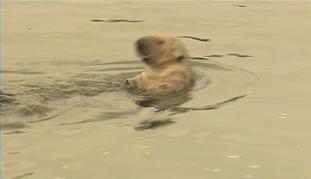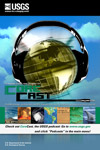USGS CoreCast
USGS Podcasts Home > CoreCast Home Page
Can't see Flash? Install Flash Player.
|
66
|

The last week in September is known as Sea Otter Awareness Week throughout California. To bring more attention to the issues surrounding the sea otter and its ongoing recovery from near extinction, we interviewed Tim Tinker, USGS lead sea-otter researcher. Video also provided in the Transcript/Links section.
Type: audio/mpeg
File Size: 5401477 bytes Duration: 5:32 Released: Mon, 23 Sep 2008 11:54:08 UTC |
Transcript:
|
[music fades in and out] Dave Hebert: Hey everybody, real quick before we start, do not forget to enter the 'Be on CoreCast Host For a Day' contest. The lucky winner you guessed it, gets to host their very own episode of CoreCast. The contest ends September 26 so make sure to enter by sending your name and e-mail address to corecast@usgs.gov. |
|
| 01:04 | What actions are being taken now to protect them? Tim Tinker: Alright, well there are a number of specific actions have been taken. One of them was to actually alter the shipping lanes in California to make sure that most ships particularly those ships carrying oil go farther offshore. And so if there is a spill, there'd be a better chance of containment. There have also been a variety of less noticeable regulations that affect how petroleum products are moved about and shipped about and handled in California. Probably the biggest action which was taken was to establish a separate colony of sea otters to a translocation in the Channel Islands in California, in San Nicholas Island which is another most remote of the Channel Islands stands south of Santa Barbara there. Colony of otters was established there in the late 1980s so that if there were big oil spill that were occurring, wiped out most of the mainland population, there would still be a separate colony of otters that we could use for recolonization. That colony has remained very small, there is still only about 40 animals there. |
| 02:02 | It is continuing to grow so hopefully eventually there will be a more substantial population there. And that was probably the most sort of single biggest action that was taken. But other than that, there's a lot of the general protections that are afforded to species that are on the endangered species list in terms of protection from incidental takes. Paul Laustsen: There is a recent USGS sea otter survey and it shows that the growth rate for sea otter has slowed in the recent years. Can you explain why that is happening? Tim Tinker: In all honesty we don't know exactly, what causes the sea otter population growth rate to increase or decrease over time. What we can say for sure is that, that rate over the last 50 years or so that the growth rate in the California population has been much slower then the growth rate of recovering populations in say Alaska or Washington and British Columbia which can grow as fast as about 20% a year. California has never grown faster than about 5% a year. |
| 03:02 | But even with a slow growth rate, we tend to see fluctuations over time. So in the late 1990s for instance, we actually had a period decline for about 5 years. This is a period of significant decline that caused a great deal of concern. At around 2002-2001, the population begin to increase again. And it was increase in, reached a rate of increase of about 5% a year so we are once again encouraged. It seemed to be recovering and was headed in the direction that might eventually allow us to delist it. Over the last couple of years, that rate of increase appears to have slowed based on a range wide surveys that we do every year. Again we don't know the specific reasons why this happens, these fluctuations except for the fact that it has to do with changes in the mortality rate of animals not in the birth rates. The birth rates of the sea otters seem to be very constant and constant both between populations and constant over time. So they are producing pups at the rate that they should be producing pups. It just seems that sometimes, they tend to start dying faster and exactly what specific factors are causing this increases in mortality is one of the sort of the goals of our study, to try and find out. |
| 04:10 | Paul Laustsen: Would someone living in the watershed that drains the Pacific ocean affect sea otters by putting too much fertilizer on their lawn? Tim Tinker: That's right, they're definitely affecting the sea otter, probably affecting a lot of other marine species as well. Sea otters are what we refer to as a sentinel species which simply means that they are by virtue of being very high profile in the public eye. And also, quite relatively easy to study or at least compared to a lot of other marine mammal and marine bird species, we can learn a lot through sea otters that tell us about other species in the ecosystem that are perhaps much harder to study or lower profile. So, yes the person washing their car, or fertilizing their lawn or hopefully not, but possibly dumping oil down the storm drain. These are all going to affect the sea otter directly and they're going to affect the habitat and a lot of other species directly as well. |
| 05:04 |
Sea otters sort of give us 'canary in a coal mine', if you will, that really lets us know that things that are not as well as they should be. [music fades in and out} |
Resources related to this episode:
- Sea otters in action

Quicktime (MOV) | Windows Media (WMV)


